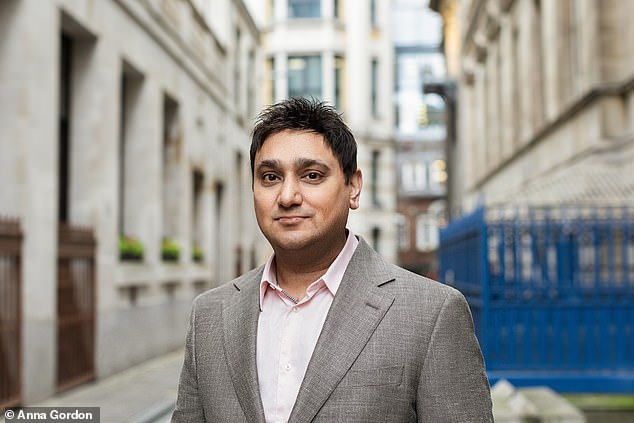Table of Contents
A candidate from The Apprentice wants to take on the US with his new technology venture, despite two bankruptcies.
Raj Dhonota, who was in the first season of Lord Sugar’s BBC show, found success in the corporate world despite being fired in the ninth week.
Over the years he has built several successful technology companies, but before the pandemic he was facing his second bankruptcy after launching a company aimed at helping entrepreneurs.
Now, despite his setbacks, he wants to move to the US to launch his technology venture.

Raj Dhonota, who appeared in the first series of The Apprentice, has been declared bankrupt twice
Bankrupt at the age of 21
After graduating in law, Dhonota began working with HSBC in drawing up the original plans for the iconic Canary Wharf building.
“HSBC was one of the first banks to outsource their paperwork to central processing departments, so I had an idea to centralize property sales,” he says.
‘Rather than having individual high street locations across the company – this was in 2000 – we set up an office for the whole of Kent.’
At the age of 21, Dhonota grew the company from 0 to 200 properties, and from a team of two to 30.
‘I should have had about £1million in my back pocket but I think I had about £25,000. We always had too little money.
“The company was great, but we always had trouble paying back, and in the end, while we were raising money, we were still making losses.”
The company went bankrupt and Dhonota was declared bankrupt for three years.
He now says he realizes he was trying to start “too big” and although he was warned to be less centralized, that wasn’t what he wanted to do.
“If we had opened some kind of store on the high street with the larger geographic area we were targeting, we might have been able to make it successful.
‘I was too adamant in my approach and didn’t listen. These are the kinds of pitfalls that many young entrepreneurs fall into.’
The intern
Towards the end of his bankruptcy, Dhonota saw an advertisement on the BBC website seeking fourteen entrepreneurs in the country for a show with Alan Sugar.
At the time, the top prize was a six-figure job with the businessman, although Dhonota says he was never particularly interested in that as a reward.
From a business perspective, I learned nothing from The Apprentice
‘I was there for nine weeks and didn’t enjoy it at all. It was more about entertainment than business.
“I’m not ungrateful to have been on the show. Out of 10,000 people it was good to be there and for the last nine weeks (but) I’m afraid to say it’s nothing to do with business and I didn’t learn anything from The Apprentice from a business perspective.”
When he left the show, he set up another company that took on insurance claims and data processing and outsourced it to a team in India.
He left the company after four years. Over the next decade, he built six other successful technology companies, including an instant translation service.
“I’ve pretty much experienced the highs and lows of business. The chances of success are slim… 80 percent of startups tend to fail within the first three years. So my success rate… I did well.”
Second bankruptcy
After several years in the tech world, Dhonota turned his attention to helping other entrepreneurs who wanted to start their own businesses.
Despite helping potential founders with their own launches, Dhonota couldn’t save his own company. The company went bankrupt just before the pandemic and he was declared bankrupt for the second time.
‘That was due to a number of mistakes… I think I could have been a lot stricter when it came to the entrepreneurs we invested in, because we invested at the very highest risk stage.
‘Before the problems started, we helped two hundred entrepreneurs. It’s not that everyone failed, it was just the last batch when the company ran into trouble.


Sacked: Raj Dhonota lasted nine weeks in the first series of The Apprentice with Lord Sugar
“At that time, I did everything I could to save the company because I was trying to help entrepreneurs and the thought of abandoning entrepreneurs who dreamed of starting their technology ventures, as I had done so many times before. ‘
However, the impact of the second bankruptcy has not phased Dhonota, who remains adamant that it is part of the ups and downs of being a businessman.
‘You obviously want to avoid bankruptcy. For me it was I did what I could and it didn’t work out, but it doesn’t stop the journey. We go on.
‘I understand that there is a negative perception surrounding bankruptcy, but I don’t see it that way. I think the mentality needs to change.
‘People are struggling with their jobs every day and should we tell them to stop working and hang up your boots? No, we don’t. I think whatever those struggles are, you just have to work through them.”
He adds that there is more of a stigma around bankruptcy in Britain than in the US, where “people accept bankruptcy as part of the entrepreneurial journey.”
Take on the US
Since his second bankruptcy, Dhonota has helped his wife start a beauty business, which now has a turnover of almost £1 million.
At the same time, he has been working on a technology venture to help the professional market in the US.
“I have always dreamed of going to the US and starting a technology company, and now I can do that. I’ve had setbacks, but I’ve always come back stronger from my setbacks and I hope it will be the same.”
This time, however, he won’t risk too much of his own money, as he believes it can be done ‘organically’… and build a team.
He plans to move to California to find a team of co-founders to build a proof of concept before approaching investors for funding.
‘This is very similar to the model we had before with many founders.
‘There are many tools available that don’t necessarily require a lot of money to build apps. It’s going to start small… that’s the approach.’
While a fresh start in the US could be the goal, two bankruptcies hanging over his head could prove difficult for Dhonota.
He is defiant that he can use “two bankruptcies in a positive light…I have no reason to hide anything.
‘History is littered with entrepreneurs who went bankrupt once or twice and went on to become enormously successful. It’s something you want to avoid, but it happened and I don’t let things like this stop me.’
With his eyes firmly on Silicon Valley, Dhonota is now looking for a team of co-founders and potential investors. Could Lord Sugar be the man he is looking for?
‘We have to sit down and negotiate. I think Lord Sugar has a certain way of doing business. I think the most important thing entrepreneurs need is a sounding board from someone who has been there and done it.
‘I certainly get value from his knowledge and not from his money. I’m confident that we can build the business, that we can make the business happen without a lot of money, but yeah, with the knowledge he has, I think it would be huge to be honest.”
Some links in this article may be affiliate links. If you click on it, we may earn a small commission. That helps us fund This Is Money and keep it free to use. We do not write articles to promote products. We do not allow a commercial relationship to compromise our editorial independence.

